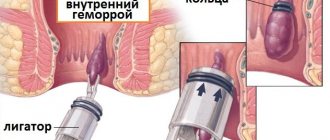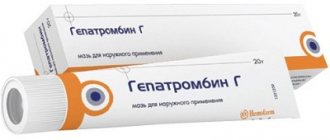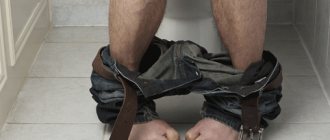Let's look at what combined (mixed) hemorrhoids are. This is the awakening of both internal and external hemorrhoids located inside or outside the anal canal. Hemorrhoids in themselves are a very unpleasant disease. If it worsens, maintaining a normal lifestyle is basically impossible. In a calm state, internal and external hemorrhoids are invisible and do not interfere with a person, but when venous blood stagnates, they swell and sink down.
The combined form is quite rare, because it is formed only when any of the forms of hemorrhoids are completely ignored separately, and it is impossible not to notice them. It should be noted that in medical practice there have been cases when combined hemorrhoids developed without any signs, thereby taking the patient by surprise. It is much more difficult to cure mixed hemorrhoids than internal or external ones due to the presence of internal and external inflamed hemorrhoids together.
Causes of combined hemorrhoids
Inflammation of the mucous membrane of the rectum and cavernous bodies. This happens with frequent constipation, which interferes with the natural cleansing of the intestines from feces.
Stagnation of blood in the rectum, abdominal organs and large intestine.
This happens due to a number of reasons:
- inactivity (sedentary, inactive lifestyle);
- obesity (being overweight);
- heavy stress in the abdominal area (most often due to heavy lifting);
- pregnancy and childbirth (during these periods a woman is most vulnerable to the development of this disease due to pressure on the pelvic organs);
- vascular diseases;
- the presence of varicose veins;
- hepatitis C (liver disease).
Any infections.
Anal sex (due to frequent and severe stretching of the anal canal, over time the sphincter muscles may no longer hold the hemorrhoids inside).
Inactivity, fast food, obesity are the “beginning” of the development of any form of hemorrhoids. To avoid illness, try to eat right and lead an active lifestyle.
Hemorrhoids
Hemorrhoids are varicose veins of the intestines. The human anus is considered the entrance to the rectum. The length of the intestinal section is 14–18 cm. Hemorrhoids are located around the anus.
The hemorrhoid consists of mucous membranes, cavities, veins and arteries, which are interconnected. When pathological expansion of the veins is observed, hemorrhoids develop. Based on location, hemorrhoids are divided into internal, external and combined.
| Internal view | Appearance | Combined view |
| It is characterized by a pathological enlargement of hemorrhoids in the rectum. It is difficult to diagnose in the early stages. | External hemorrhoids are easier to identify even during the initial examination and palpation. Hemorrhoids are located under the soft tissue around the anus. | Accompanied by a violation of the outflow of blood in both external and internal hemorrhoids. The rehabilitation period will be longer than with the above types of pathology. |
By nature, proctologists distinguish acute and chronic forms:
- The acute form of hemorrhoids is accompanied by bleeding from the anus, severe pain, and an increase in the size of the hemorrhoids.
- The chronic form or remission is practically asymptomatic and has no manifestations.
Each form or phase of proctological disease requires special attention and an individual approach.
Diagnosis of the disease
Diagnosis of combined hemorrhoids is carried out using the same methods that detect individual forms of this disease. Differential diagnosis is carried out with the expectation that the symptoms of this disease may be similar to other pathologies, including cancer. Therefore, only a qualified specialist can diagnose mixed hemorrhoids, based on the symptoms when examining the patient. If necessary, the proctologist may prescribe other examination methods in order to clarify the pathology. Self-medication should not be practiced under any circumstances; a person can unintentionally complicate the course of the disease.
Treatment methods
The following methods are used in the treatment of hemorrhoids:
| Hemorrhoid stage | Treatment |
| First | Creams, gels, rectal suppositories, drugs, sclerotherapy, photocoagulation, Bicap diathermocoagulation |
| Second | Hardening of nodes, medications, photocoagulation, latex ring ligation, thermal probe, Ultroid current |
| Third | Drug therapy, latex ring ligation, Ultroid current, hemorrhoidectomy |
| Fourth | Hemorrhoidectomy, phlebotropic drugs |
In the early stages of hemorrhoids, traditional medicine using herbs, decoctions and mixtures is also used.
Treatment of combined hemorrhoids
With mixed hemorrhoids, the doctor faces two tasks at once:
- reduce the size of enlarged hemorrhoids inside the anal canal;
- removal of external hemorrhoids that have fallen out of the anal canal.
Treatment is carried out in two directions simultaneously. The doctor must decide on the need and scope of surgical treatment; on the other hand, he must prescribe medication treatment.
How combined hemorrhoids will be treated directly depends on the degree of development of the disease. It is generally accepted to distinguish between four degrees of mixed hemorrhoids, and at each degree the treatment will differ significantly.
There are 4 stages of development of mixed hemorrhoids. Do not allow the disease to progress; at the first symptoms, consult a specialist
Combined hemorrhoids 1st degree
Usually, when diagnosing mixed hemorrhoids of the 1st degree, conservative (non-surgical) treatment is used. This is taking various medications (tablets, ointments, suppositories) that can improve a person’s condition, reduce or completely eliminate pain, swelling of the walls of blood vessels.
Combined hemorrhoids 2 degrees
Stage 2 is treated by freezing the hemorrhoids. The name of this method is cryodestruction. This is the removal of tumors and defects with liquid nitrogen. In the second degree of mixed hemorrhoids, it is also possible to tighten the hemorrhoids using latex rings.
Combined hemorrhoids 3rd degree
Treatment for stage 3 mixed hemorrhoids will be much more serious than the previous two. If at the 1st and 2nd stages of development it was possible to get by with medications, then it is possible to cure the third stage only with the help of surgical intervention. This is explained by the fact that all hemorrhoids (external and internal) are already quite large in size, they limit the patient’s movement. Treatment of grade 3 combined hemorrhoids with latex rings is extremely rare, only if the nodes are not too enlarged. The main method of treatment at this stage is surgery using the Longo method. Using special titanium plates, the inflamed nodes are pulled up. This method has good reviews, and the patient can be discharged within 2-4 days after the operation.
Symptoms of hemorrhoids in men and women
A person who develops hemorrhoids may initially experience a feeling of discomfort in the anus from time to time, which in most cases is the main signal of the development of hemorrhoids.
Later, other symptoms of the disease appear.
Sensation of a foreign body in the anus, hemorrhoids heaviness and inflammation. These manifestations may be one of the first symptoms of hemorrhoids. They arise due to swelling and displacement of the internal folds of the anal canal. They may not bother you all the time, but only at certain times.
Anal itching and burning. Such unpleasant symptoms of hemorrhoids arise as a result of prolapse of hemorrhoids, as well as the release of blood and mucus, which irritates the mucous membrane and skin in the anus area. Chronic hemorrhoids cause itching during bowel movements.
Bleeding. This is the most typical symptom of hemorrhoids. Bleeding is periodic and can also vary in duration and color. In most cases, they occur during bowel movements, but it is possible that they may occur in the intermediate period. Blood may be released in the form of droplets after the stool is passed, and may also be present in the stool itself. Depending on the severity of the bleeding, blood can leave marks ranging from small marks on toilet paper to large splatters on the toilet.
Prolapse of hemorrhoids. Hemorrhoids are dilated veins of the choroid plexuses of the rectum. Their loss is one of the most characteristic symptoms of hemorrhoids. There is a direct relationship between this symptom of hemorrhoids and the stage of the disease. At the initial stage, the fallen nodes are easily set inward on their own, and at later stages they are set only as a result of manual intervention, or are not set at all.
Pain. As a result of the progressive development of hemorrhoids and strangulation of hemorrhoids, pain is a common symptom of the disease. They can occur during bowel movements, while walking, while sitting, and can also be permanent. Often the pain intensifies with exacerbation of hemorrhoids.
If you have hemorrhoids and you have a question about which doctor to see, then the answer is simple - you should make an appointment with a proctologist.
Increasing the amount of dietary fiber and fluid in your diet will help reduce symptoms. Good sources of dietary fiber include bread and bran products, fruits and vegetables. Reducing the force and duration of straining during bowel movements will reduce the pressure on hemorrhoids and prevent their prolapse.
Course and manifestation of hemorrhoids
Hemorrhoids are usually characterized by a periodic course, that is, periods of exacerbation and remission.
The listed symptoms and signs of hemorrhoids most often bother patients during the development of the disease and are serious signals for taking emergency measures.
Hemorrhoids, like many other diseases, are much easier to cure in the initial stages of the disease, otherwise the patient will face surgical intervention and a long course of treatment. If nothing is done against hemorrhoids in time, the disease may be accompanied by the occurrence of other diseases against its background, such as chronic and acute anal fissure, anemia, rectal fistula, thrombosis, ulcers around the rectum, and weakened ability to retain gases.
In advanced cases, complications of acute hemorrhoids may develop, such as massive bleeding, swelling of the anus, purulent paraproctitis (purulent inflammation of the tissue), necrosis (death) of hemorrhoidal tissue.
The dangerous consequences of hemorrhoids are polyps and malignant tumors of the intestine, which have symptoms similar to hemorrhoids. Pain and bleeding during bowel movements can be a manifestation of rectal pathologies such as polyps or cancer.
Stages of hemorrhoids
| Stages | Symptoms | Clinical picture |
| 1 | Bleeding, discomfort | Hemorrhoids do not protrude from the anal canal. The vascular pattern of the mucous membrane is enhanced |
| 2 | Bleeding, prolapse of nodes, itching, mucous discharge | Hemorrhoids prolapse during bowel movements and then reset on their own |
| 3 | Bleeding, prolapse of nodes, anal itching, mucous discharge | Hemorrhoids fall out not only during defecation, but also during physical stress and are manually adjusted by the patient |
| 4 | Bleeding, constant prolapse of nodes, anal itching, sphincter incontinence, pain syndrome | Constant prolapse of hemorrhoids, with the impossibility of their reduction |
Do you doubt your health?
Make an appointment with a proctologist and get rid of your worries. We have discounts until the end of April. To find out the price, click “register online” and select a clinic. Registration online
Treatment of combined hemorrhoids with folk remedies
Treatment of hemorrhoids only with folk remedies is unacceptable, but together with drug treatment it will significantly speed up the patient’s recovery. It is important to remember that without consulting a highly qualified specialist, it is undesirable to take measures on your own, even using herbs and infusions.
Also, many patients are hostile towards traditional medicine, but there are several truly effective recommendations that help alleviate the patient’s condition:
- Taking a cold bath. This method is often used if it is necessary to stop bleeding from the anal canal and also reduce pain. This method is very simple, you need to pour ice water into a basin and sit in the container for a short time (about 2-3 minutes). It is recommended to do this procedure no more than once or twice a day.
- Using red beets. Red beets are grated with shavings on a fine grater. Finely grated beets are spread evenly on gauze, then the resulting compress must be applied to the sphincter area. This method quickly relieves itching and accompanying pain.
- Candles made from chamomile infusion. It is necessary to pour a tablespoon of dried herb (chamomile) into a small vessel and fill it with a glass of water. Place the vessel on the stove and boil it for about 10 minutes. After you have cooled the broth, strain it and pour it into small molds, the size of which should not exceed the size of pharmaceutical suppositories. After freezing the broth in molds, the prepared candles must be inserted into the anus. The remedy is simple, but very effective. It will help to quickly relieve inflammation of hemorrhoids, itching, burning and pain in the sphincter area and anal canal.
- Candied honey is poured into molds, the size of which is similar to pharmaceutical suppositories. After the honey has hardened, the resulting candles are inserted into the anal canal in the same way as pharmaceutical candles.
Folk remedies can significantly alleviate the course of the disease, but only on the recommendation of a qualified specialist, and also together with medications. Without concomitant treatment, traditional medicine is unable to relieve a patient of hemorrhoids of any form or degree.
Hemorrhoids 3rd degree
This stage is considered dangerous to human health. Surgical intervention rather than conservative treatment is used. The operation is performed if drug therapy does not bring the desired effect. The size of hemorrhoids is rapidly increasing. The formations fall out of the anus, the patient cannot put them back inside without the help of a medical specialist.
The help of a qualified doctor is required, since repositioning of the nodes inward is required after defecation. This procedure will help avoid discomfort and pain, and not cure the pathology. The use of medications at stage 3 of hemorrhoids is effective only to alleviate the condition and eliminate pain. Treatment of third-degree hemorrhoids with folk remedies makes no sense.
Hemorrhoids grow daily, so invasive treatment methods are used. If you avoid treatment and visiting a proctologist, third-degree hemorrhoids develop into rectal cancer and pose a serious threat to the health and life of the patient.
Infrared photocoagulation method
In this case, treatment of the hemorrhoid is carried out by cauterizing it at several points at the base (from two to six). The duration of the session is very short, only 10-15 seconds.
The patient does not experience any particular discomfort or pain. During the procedure, he lies on his side on the couch with his knees pressed to his chest. His body is covered with special proctological underwear, in which a hole is left for inserting an anoscope. This is an important point, because eliminates the tightness that occurs in some patients.
Point cauterization of the base of the hemorrhoidal node deprives it of adequate nutrition, which subsequently leads to the complete death of the node. To prevent pain during the procedure, the patient may be given local anesthesia using special gels.
Infrared photocoagulation is a gentle technique that does not cause excessive bleeding. No sick leave is required, the recovery period is minimized.








